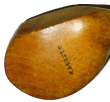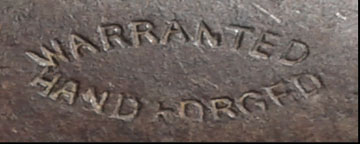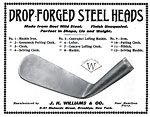
|
Registration Edit profile catalogue auction shopping cart shipping history makers search faq news links about contact |

Scottish Golf History
ClubmakingWarranted Hand Forged(Source: © 2013, Douglas MacKenzie) Almost anyone who has seen an antique iron club will have seen the stamping “Warranted Hand Forged” and many is the eBay description which takes this to mean that the club was handmade from scratch, presumably from a piece of iron ore, by whomever’s name is stamped on the back.
I have occasionally reprised the meaning in descriptions of clubs on the site but the maxim I have oft repeated that there is never anything really new in golf was brought home to me by a bunch of American golfers getting exceedingly grumpy with one another in internet forums recently about a New York Times article on Miura irons and the forging process. Did hitting them three times with a hammer connect them to Samurai swords and render them superior to those hammered twice? I have no idea (and having been bashed over the head with a putter by a cousin losing a match (we weren’t big on golfing etiquette as kids) elasticity was not a concept I associated with iron clubheads) but it did immediately bring to mind the vituperative exchanges in Golf, the USGA magazine, of 1898. The “Warranted Hand Forged” mark only started appearing on Scottish and English made clubs around 1897 because, up to this point, it was the only way clubs were made, a continuation of the blacksmith’s art and essentially involves taking a piece of hot iron and bashing it into shape with a hammer. As a result, no two clubheads made by this method are exactly alike. Then along came those technology-crazy Americans proposing making clubs using the drop forging method which formed clubheads as an impression in a die under a drop or steam hammer. Each one came out exactly the same. Forget questions as to which is the better clubhead for now. The drop-forging method is clearly cheaper in large-scale production but requires an investment most small Scottish producers could not contemplate. To your clubheads, gentlemen! The “Warranted Hand-Forged” stamp was a badge for the old ways and, whatever the technological arguments, it clearly carried weight because we see American manufacturers, and importers such as Harry Lee, stamping clubs Forged or, on a Goldsmith club Warranted Athletic Goods which seem rather defensive and an attempt to mimic something they recognise as having considerable marketing value. But an interesting war was waged in the golfing press. An anonymous writer (“Scotchman”) kicked off the debate in a letter to Golf magazine in London in January 1898. I need not rehearse the arguments as they are apparent from the response in the following month’s Golf New York version which I repeat in full as I am an unabashed fan of the sneering tone. It was also anonymous but here’s a clue. The editor referred to ‘an esteemed correspondent’ which meant an advertiser (I told you nothing changed in golf) and there is not one but two advertisements in that edition for J H Williams of Brooklyn, the leading exponents at that time of drop-forged clubheads.
An esteemed correspondent sends me the following:- “We have been interested, not to say amused, by a letter in relation to ‘drop-forged steel clubs’, published in Golf London on January 14th. Our interest in the abysmal ignorance shown of the drop-forging process as carried on in America is equalled by our amusement at the naοve statement that ‘steel can be hand-forged equally as well as iron’. It is pleasant to learn that ‘no golfer would use a steel head after he has first played with an iron one. We will undertake to furnish a lot of heads to any golfer part of which shall be steel and part iron, and will challenge him to detect by sight or by use any difference between them so far as the ball leaving the club better and keeping in better line is concerned. Drop-forged goods are superior to hand-forged because, in the first place, a fine quality of material is essential to the process poor stock cannot be handled to advantage by it; in the second place, the blows of the heavy hammers used in drop-forging consolidate the metal, leaving it in a much more compact, condensed and homogeneous condition than is possible by hand forging. Thirdly, all being forged in dies, the contour of all is exactly alike, which is an impossible thing to secure in hand-forgings. The Scotch writer to whose communication we refer appears to draw no distinction between soft steel and cast steel, and seems not to know that steel can be furnished and is commonly used that is as soft as the softest iron; and that its hardness and other characteristics cab be, and are readily varied at will. The plain, substantial fact is, that soft steel is a better material in every way than iron, stronger and freer from injurious chemical and mechanical constituents; and when treated by the drop-forging process it makes a better forging than is possible by hand, whether of steel or iron; and that no iron hand-forging is equal to a steel drop-forging if a fine quality mild steel is used. The matter is not one of opinion or prejudice, but can readily be tested by a trial of specimens of both. We would courteously suggest that the gentleman whose letter we criticise use one of the drop-forged heads for a short time before making further comments upon alleged ‘beginners’ and before posing as one of ‘those who know better’ about steel and iron than manufacturers of high standing and large experience such as are producing the goods in this country. If the gentleman will permit, we shall be very glad to give him an opportunity to make practical trial of the goods he so unjustly shall we say, ignorantly? condemns. If any user of heads desires a sufficient number they can be drop-forged from iron as well as from steel. Here, too, there would exist all the advantages of the drop-forging process, but the final result would not be as good as if drop-forged from fine soft steel. Any players interested may address replies to “Drop-forged” care of this office.
Despite having pursued a chemistry degree I found better places to be when third year lectures on the inorganic stuff took place, so may have missed some relevant theory, but the idea that one big bang from a drop hammer renders homogeneity better than six hundred or so blows in hand forging seems unlikely but why employ scientific enquiry when we have the vitriol of the next month’s correspondence from ”A Scott”? ‘the metal . is left as much consolidated after being treated with hand hammer and anvil . Not only this, but it is left in a far more elastic condition . It takes men with taste and brains, and those who are not afraid to sweat the arduous but honourable occupation to make golf clubs by hand. It is the work of such men that drop forgers are using as models . In many cases they make pretty fair copies, though to the experienced eye many defects can be pointed out.’
In the next issue the earlier drop-forging proponent, John Lee of Brooklyn. reveals his identity in criticising this letter and the ‘child-like confidence of the writer in the gullibility of his readers’ and wishes to point out The April edition has “A Scott” shed his cloak of anonymity also. He is James Cran of Chicopee, no dyed in the wool traditionalist, inventor of the Cran cleek and developer of patents for Spalding and Wright and Ditson. ‘There is just as much difference between a hand-forged golf club and one that has been drop forged as there is between a fine oil painting and a cheap print, which may look just as good to those who do not know the difference; but still one is a work of art, while the other is but the outcome of a mechanical operation. I think I am as able to speak upon this matter, as I can say without exaggeration that I have handled more golf clubs in one year than either Mr Lee or Mr J D Dunn has done in his lifetime’. So, who won the argument? Two years later J H Williams seems to have gone out of business and J D Dunn applied for reinstatement as an amateur. James Cran applied for a patent for a variable weight golf club head with the specification, ‘The invention is particularly applicable to iron clubs, which are preferably made of soft steel and drop-forged, but may also be made of malleable iron or other metal and formed in any suitable manner’. Oh, and the modern argument which brought this to mind? Retief Goossen was asked about the Miura clubs he used to win the 2001 US Open. “I didn’t know he did my clubs. I hit it pretty solid that week.” |
site design dmc ltd | © 2000-2024 Antique Golf Clubs from Scotland
 The typical hand-forged mark
The typical hand-forged mark
